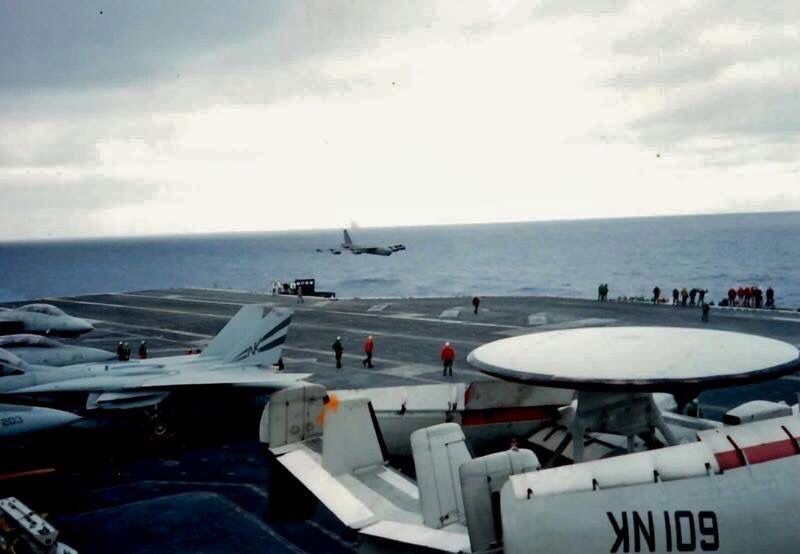
|
|
SUBSIM: The Web's #1 resource for all submarine & naval simulations since 1997
 |
SUBSIM: The Web's #1 resource for all submarine & naval simulations since 1997 |
 09-01-20, 09:58 AM
09-01-20, 09:58 AM
|
#1 |
|
Fleet Admiral
 |
Can a B52 bomber approach a US Aircraft Carrier close enough to engage with missiles without being detected?
An interesting question. The US Navy and US Air Force tried to find out in the 1990's in a joint exercise in the Persian Gulf. At first, it may seem to be a silly self evident question. B52s are big and relatively slow moving and Aircraft Carriers have lots of radars and aircraft with lots of radars protecting it. Well the crew, and especially the CO of the USS Ranger (CV-61) were surprised when two B52s called for permission to overfly the USS Ranger when at a distance of approximately 9,000 meters. This radio call was the first indication that the Aircraft Carrier, or any of the aircraft, were aware of the proximity of the two B52s that came from Guam. Pictures or it never happened!  This, ladies and gentlemen, is a B52 flying under the level of the deck of an Aircraft Carrier. That's about 50 feet above the water! Fake picture? Here are some more.   The phrase "keeping under their radar" comes to mind.  This is one of many reasons why Aircraft Carriers are usually surrounded by other ships. Sometimes, visual may be the only indicator. Now imagine what a much smaller missile traveling much faster could do? Pretty cool exercise and pretty good flying of a B52. I bet that ate up some fuel. 
__________________
abusus non tollit usum - A right should NOT be withheld from people on the basis that some tend to abuse that right. |

|

|
 09-01-20, 11:05 AM
09-01-20, 11:05 AM
|
#2 | |
|
Chief of the Boat
|
Most impressive and easily believable.
The Blackburn Buccaneer would often exercise at approaching ships at an altitude of 30 feet but they were considerably smaller in size. Quote:
|
|

|

|
 09-01-20, 01:35 PM
09-01-20, 01:35 PM
|
#3 |
|
Soaring
|
__________________
If you feel nuts, consult an expert. |

|

|
 09-01-20, 02:13 PM
09-01-20, 02:13 PM
|
#4 |
|
Ocean Warrior
 |
B-52 G and H models could carry (I think?) 5 Harpoon missiles on hard points under the wings. The Harpoon mission would travel from squadron to squadron but all B-52 crews practice launching them.
The typical employment exercise would also involve at least one P-3 Orion.  You can read about these B-52 Harpoon missions in a book by Jim Clonts called When Penguins Flew And Water Burned. 
|

|

|
 09-01-20, 03:24 PM
09-01-20, 03:24 PM
|
#5 |
|
CINC Pacific Fleet
 |
Until I got this Command modern operation I was always convinced they only carried bombs of different sizes and nukes.
Now I know they carry a lot more. Harpoon Tomahawks And so on. Markus |

|

|
 09-01-20, 04:30 PM
09-01-20, 04:30 PM
|
#6 |
|
Ocean Warrior
 |
The Harpoon mission for the B-52 is kind of odd, its as if SAC was trying to "elbow" its way into Navy ops, again.
 As Jim Clonts describes it, it was also one of their more demanding missions. In many ways, the B-52 is an ideal platform to carry Harpoons, its has almost a day's worth of loiter and travel time. That said, its also a Navy mission and the Navy treated B-52s accordingly.  As far as how they do/did it, Clonts wrote that the B-52's Nav had control of the positioning and launch, as opposed to normal ops which were controlled by the Aircraft Commander and/or the Rnav (radar nav/bombardier). In short, it was the Nav's show and it required extremely tight timing to get the plane and the missiles to the launch point at the proper time. |

|

|
 09-01-20, 04:45 PM
09-01-20, 04:45 PM
|
#7 |
|
CINC Pacific Fleet
 |
Another thing when it comes to fly just above the water.
I recall some words from a Swedish book which was the Story of the Swedish aviation-including its airforce and the future. In this book or perhaps in some other book They wrote something about buoyancy that warm air from the water may/could give an airplane extra buoyancy. Now I could be wrong/remember wrong. Markus |

|

|
 09-01-20, 05:09 PM
09-01-20, 05:09 PM
|
#8 |
|
Ocean Warrior
 |
That sounds like "ground effect" where the air beneath the plane's wing starts to compress against flat ground.
There were stories of B-52s during the early low-level strikes of Dessert Storm where the pilots were flying much lower (less than 200 feet above ground) than they were used to and they were surprised how much effort it took to keep the plane below the ground effect. |

|

|
 |
|
|
